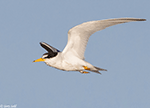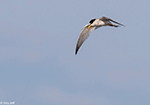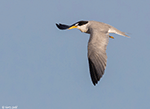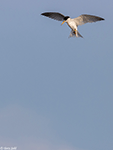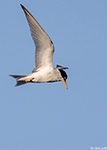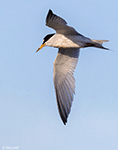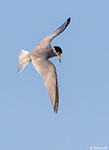| Length: 8 to 9 inches | Wingspan: 20 inches | Seasonality: Summer |
| ID Keys: Small size, yellow bill with black tip, black cap and nape with distinct white forehead, orange-yellow legs | ||
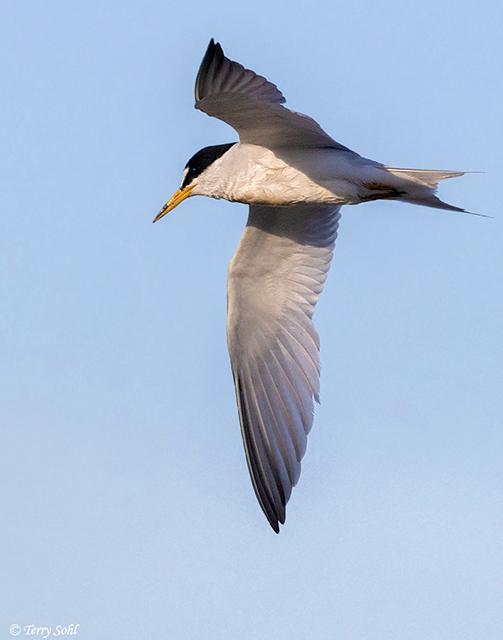 The Least Tern is the
smallest of the North American terns. They breed in two distinct habitats,
the sandy beaches of the Atlantic and the Californian Pacific coast, and on
sandbars on large river systems in the interior of the country. Both the
coastal and inland populations have been considered endangered in the United
States, although with protection under the Endangered Species Act since
1985, populations have rebounded in recent decades. In South Dakota, they breed
along sandbars of the Missouri River system, but with the series of dams from
southeastern South Dakota northward through North Dakota, much of that
habitat has been inundated. Even where sandbar habitat remains, unnatural
water releases and water regulation from the dams may result in nesting
failure. Along the coastlines, they are threatened by
human disturbance on their nesting beaches. There is some hope that
coastal populations, at least, have adapted to a human presence somewhat by
including gravel roofs as areas to nest. As noted above, with extensive
protection, inland populations are also rebounding.
The Least Tern is the
smallest of the North American terns. They breed in two distinct habitats,
the sandy beaches of the Atlantic and the Californian Pacific coast, and on
sandbars on large river systems in the interior of the country. Both the
coastal and inland populations have been considered endangered in the United
States, although with protection under the Endangered Species Act since
1985, populations have rebounded in recent decades. In South Dakota, they breed
along sandbars of the Missouri River system, but with the series of dams from
southeastern South Dakota northward through North Dakota, much of that
habitat has been inundated. Even where sandbar habitat remains, unnatural
water releases and water regulation from the dams may result in nesting
failure. Along the coastlines, they are threatened by
human disturbance on their nesting beaches. There is some hope that
coastal populations, at least, have adapted to a human presence somewhat by
including gravel roofs as areas to nest. As noted above, with extensive
protection, inland populations are also rebounding.
Habitat:
In the interior of the country, breeds on large river systems with large exposed sandbars. Along the coastline, breeds on sandy beaches adjacent to shallow water. During the winter, found along tropical coastlines and sometimes far out to sea.
Diet:
Primarily feeds on small fish, crustaceans, and insects. Will also eat small mollusks and marine worms if available.
Behavior:
Forages while in flight, hovering over the water and plunging down just below the surface to capture fish and other prey items when spotted. They are also capable of catching flying insects while in flight.
Nesting:
May through July in South Dakota. The nest of a Least Tern is a simple scrape in the sand of a river sandbar or beach, often without lining or other augmentation, but they will sometimes put bits of vegetation or pebbles in the nesting scrape. On occasion they will also use the gravel-covered roof of a building. The female lays between 1 and 3 eggs, with both parents helping to incubate them. The young hatch after about 3 weeks. Their stay in the nest is typically short, just a few days, before venturing out. The parents continue to tend and feed the young, who typically take flight about 3-4 weeks after hatching.
Song:
Squeaky, high-pitched zreeep! alarm and flight calls, as well as shorter "barking" calls.
1Click here to hear the squeaky flight calls of Least Terns
Migration:
In summer, can be found locally inland on large river systems, along the Atlantic coast, and locally along California's Pacific coast. Both coastal and interior populations migrate well to the south in winter, inhabiting tropical waters down through Brazil.
Interactive eBird map:
Click here to access an interactive eBird map of Least Tern sightings
Similar Species:
There are several tern species found in South Dakota, either during the summer breeding season or during migration. Least Terns could potentially be confused with the following species:
- Forster's Tern - Forster's Tern is another black-capped tern species that nests in South Dakota. Forster's Terns are significantly larger than Least Terns, but that identification point may be difficult for a bird seen in isolation. Forster's Terns have a completely black cap, while the cap on a breeding plumaged Least Tern has a white mark on the forehead. The bill of a Forster's Tern is orangish with a black tip, while the bill of a Least Tern is yellow.
- Common Tern - Common Terns are very similar to Forster's Terns, but are less common in South Dakota. Compared to Least Terns, Common Terns are larger, with a completely black cap (again, compared to the black cap with white forehead on a Least Tern). The bill of a Common Tern in breeding plumage is reddish-orange, compared to the yellow bill on a Least Tern.
- Black Tern (in non-breeding plumage) - Black Terns are easily distinguished from Least Terns while in breeding plumage, as they are (surprisingly) mostly black! In non-breeding plumage they could be confused with an immature Least Tern. Even in non-breeding plumage, however, Black Terns are darker overall than Least Terns, with a longer black bill.
South Dakota "Hotspot":
Given their unique habitat needs for nesting, distribution of Least Terns during the summer breeding season is quite limited. The vast majority of all summer sightings are in the lower part of the Missouri River as it passes through the state, along the Nebraska border. The stretch of river from below Gavin's Point dam along the Nebraska border, down to Sioux City, is free-flowing and undammed, and has a number of locations where extensive sandbars still offer great nesting habitat. North Alabama Bend Park, just southwest of Vermilion, is one location that traditionally has very large, extensive sandy flats where both Least Terns and Piping Plovers will nest.
Conservation Status:
Least Terns are threatened in many parts of its range. In the interior of the continent, damming of major rivers such as the Missouri in South Dakota have resulted in much of their normal nesting habitat (river sandbars) to be submerged. Even where sand bars exist, unnatural water fluctuations due to regulation of river water from dams often results in unsuccessful nesting. On the coastlines, human disturbance on beach nest sites often causes unsuccessful nesting. The species has undergone significant declines in the last several decades.
The population of Least Terns breeding on the interior of the continent have been most at risk. In May of 1985, the species was officially labeled as "endangered" by the US Fish and Wildlife Service. Populations of interior Least Terns at the time were estimated to have dropped below 2,000 in total. Since protection, populations have rebounded in the last few decades. By 2020, total populations of interior Least Terns were approaching 20,000, and discussions were beginning to officially de-list the Least Tern from the Endangered Species Act.
For the total population (interior and coastal populations, Least Terns have always been found across a broad geographic area and total population losses never quite yet meet established thresholds for labeling the species as a whole as "threatened". At a global scale, the IUCN considers the Least Tern to be a species of "Least Concern".
Further Information:
Photo Information:
July 3rd, 2020 - North Alabama Bend Park near Vermilion, South Dakota - Terry Sohl
Audio File Credits:
1Isain Contreras Rodriguez - Recorded in Sinaloa, Mexico on June 10th, 2020. Original recording and information from xeno-canto.
2William Whitehead - Recorded in Monmouth County, New Jersey on June 5th, 2020. Original recording and information from xeno-canto.
| Click on the map below for a higher-resolution view |
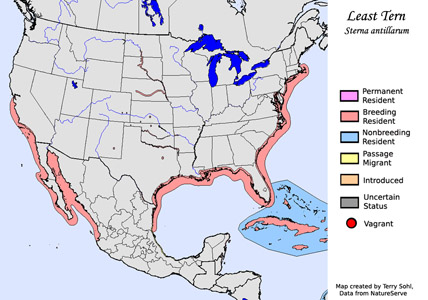 |
| South Dakota Status: Uncommon and local summer resident along the Missouri and Cheyenne rivers. Accidental migrant elsewhere in the state. |
Additional Least Tern Photos
Click on photos below for higher-resolution views, or the link above for photos and information.
